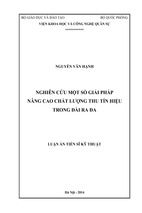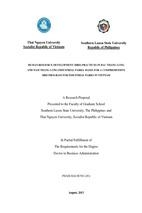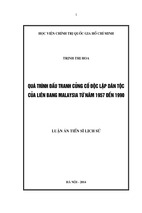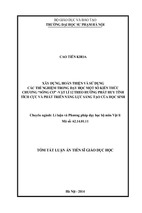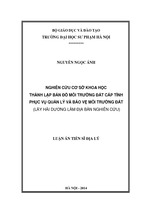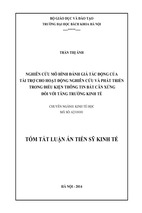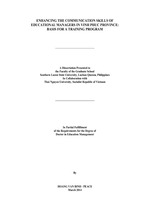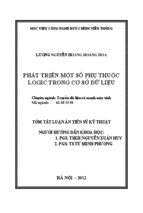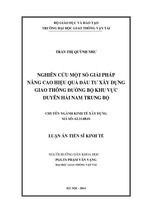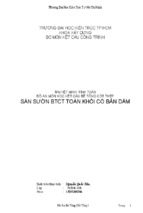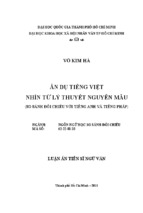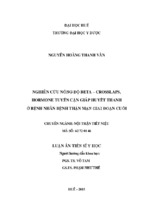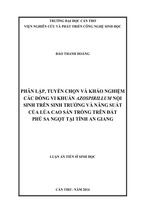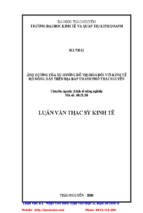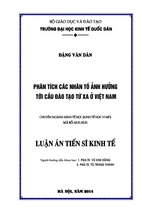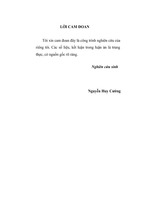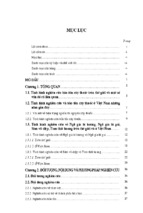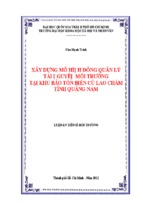VIETNAM ACADEMY OF SOCIAL SCIENCES
GRADUATE ACADEMY OF SOCIAL SCIENCES
LE HUYEN TRANG
RETAIL SERVICE QUALITY
OF SOME SUPERMARKETS
IN HANOI
Major: Business Administration
Major code: 9 34 01 01
SUMMARY OF DOCTORIAL THESIS
IN BUSINESS ADMINISTRATION
HA NOI - 2019
The thesis was completes at
Graduate Academy of Social Sciences
Academic Supervisor: 1. Assoc.Prof. Dr. Nguyen Khanh Doanh
2. Dr. Nguyen Thi Ngoc
Reviewer 1: Assoc.Prof. Dr. Le Thi Thu Thuy
Reviewer 2: Assoc.Prof. Dr. Tran Thi Minh Chau
Reviewer 3: Dr. Duong Ngoc Thanh
The thesis is defended against Academy-level Examination
Board at Graduate Academy of Social Sciences
Time: ………… date………month……….year 2019.
The thesis can be found at: National Library of Vietnam and
Library of Graduate Academy of Social Sciences.
PREAMBLE
1. The urgency of the topic
Over the years, Vietnam is one of the most attractive retail markets in the
world. In particular, Hanoi is one of the major retail development centers. In particular,
modern retail forms such as general supermarkets and specialized supermarkets are
increasing in number. This leads to fierce competition between domestic supermarkets
and foreign supermarkets. Therefore, in addition to improving the quality of products
and goods, supermarkets need to pay attention to their service provision activities.
However, to improve service delivery, Vietnamese supermarkets face difficulties in
capital issues and management methods. Therefore, the topic "Quality of retail services
of some general business supermarkets in Hanoi" is selected by the author to assess the
status of service quality both from managers and customers , assess the strengths and
limitations of the problem, thereby suggesting some solutions to improve and improve
research issues.
2. Aims and tasks of the study
2.1. The aims of the study
Clarifying the current activities of retail service quality of supermarkets in
Hanoi; Since then, propose solutions and recommendations for Hanoi s upermarkets to
improve the retail service quality to meet the demand of customers in the current
period.
2.2. The tasks of the study
First, overview of research materials related to retail service quality, customer
satisfaction and loyalty
Secondly, synthesize theory and explanation of the theoretical basis of retail
service quality, customer satisfaction and loyalty.
Third, building and testing theoretical and hypothetical models to assess the
status of retail service quality in general business supermarkets in Hanoi.
Fourth, based on the research results, propose a number of solutions to
improve the quality of retail services, improve customer satisfaction and loyalty in
general business supermarkets in Hanoi.
3. Subjects and scope of the study
3.1. Subjects of the study
The research subject of the thesis are defined the retail services quality of a
number of general business supermarkets in Hanoi and the relationship between quality
of retail services with customer satisfaction, customer loyalty.
3.2. Scope of the study
+ Scope of content: The thesis focuses on researching the quality of retail
services with the satisfaction and loyalty of customers at a number of general business
supermarkets in Hanoi.
1
+ Scope of time: For primary data: the author collects data in the period
mainly from 2010-2016. For secondary data: the author collects data through a
customer interview during the period from September 2016 to September 2017.
+ Scope of space: According to the internal approach (from the supermarket):
Because many supermarkets are not interested in improving service quality, Big C is
the exception (due to the legal room) present social responsibility and improve service
quality). Other supermarkets hardly have this activity. Besides, the assessment process
of QoS of QoS is only administrative, may not be compatible between the process and
the law. Therefore, the results of in-depth interviews with some supermarket managers
show that this approach is not feasible and does not achieve much results.
According to an external approach (From customers): Surveying 500
customers in some general business supermarkets in some urban districts of Hanoi such
as VinMart Trung Hoa, CoopMart Saigon, FiviMart Dai La, Intimex Giang Vo, BigC
Thang Long, Lotte Mart Ba Dinh, Aeon Citi Mart Golden Palace, Muong Thanh HH2
Linh Dam. This is an appropriate approach, assessing the quality of CLD because
customer assessment is most objective and appropriate.
4. Methodology and research methods of the thesis
- Methods of collecting and systematizing documents.- Methods of analysis and
synthesis -Comparative method
-Professional solution
- Intensive interview method
- Typical case study method
- Method of investigation by questionnaire
- Methods of data processing: Verification of Cronbach’Alpha reliability
coefficient, Exploratory factor analysis (EFA), Confirmatory Factor Analysis (CFA),
tructural Equation Analysis (SEM).
5. New scientific contributions of the thesis
The thesis is a comprehensive and systematic research on retail service quality
in some supermarkets in Hanoi. The research results of the thesis have some new
contributions:
The thesis has built a research model to evaluate the retail services quality
reserved for general business supermarkets in Hanoi. Based on the research point of
retail service quality of Dabholkar and Mehta, the thesis has been revised and
supplemented to suit the context of retail service business in Vietnam
The dissertation developed a scale of retail service quality based on a number
of studies in the world, but the author has some necessary adjustments.
The author uses the method of linear structure analysis (SEM) to
simultaneously test the relationship of retail service quality to customer satisfaction and
loyalty.
The study was based on 4M & 1E models to analyze theoretically some groups
of factors affecting the quality of retail services. Adding a perspective on assessing the
quality of retail services, it is to improve the quality of retail services not only
accessible from the outside - customer perception, but also approach from the internal
side - supermarkets.
2
In addition to assessing service quality based on customer perception, the
thesis also analyzes the status of retail service quality based on assessments of
supermarket managers. As a result, the assessment of the quality of retail services at
supermarkets will be more complete, the proposed solutions will be seen more
comprehensively from both the supermarket and customers.
Besides, the dissertation also analyzes and points out the experience of
improving the retail services quality of some major supermarkets in the world and
Vietnam. From there, give lessons learned about research issues.
6. The theoretical and practical meaning of the thesis
6.1. Theoretical meaning
Research results of the dissertation serve as a theoretical basis in studying the
situation and proposing solutions to improve the quality of retail services in some
supermarkets in Hanoi.
6.2. Practical meaning
In practical terms, the research results of the thesis can be used as a guiding
document in practical activities as well as teaching research on retail service quality.
7. Structure of the thesis
Apart from the introduction, conclusions, references and appendices, the main
content of the thesis consists of 5 chapters as follows:
Chapter 1: Literature review.
Chapter 2: Theoretical issues about quality of retail services, general business
supermarkets
Chapter 3: Research design
Chapter 4: Current situation of retail service quality of some general business
supermarkets in Hanoi
Chapter 5: Some solutions to improve the quality of retail services at general
business supermarkets in Hanoi city
Chapter 1
LITERATURE REVIEW
1.1. Overview of research projects
Research works on retail service quality in the world and in Vietnam, the
author learns and classifies into three main groups:
- The research team studied the components that constitute the retail service
qualiy at businesses and supermarkets. In this group, the author divided into 3 main
issues:
+ Group of studies proposing commodity factors into the quality assessment
model of CL.
+ The research team applies 5 elements of retail service quality (Model
RSQS): Tangible factors, Confidence, personal interaction, complaint settlement,
supermarket policies.
+ Group of research projects proposed new elements of retail service quality
based on RSQS model.
- The research team studied the factors that constitute the quality of online
retail services in businesses and supermarkets.
3
- The research team studied about the relationship between quality of retail
services and customer satisfaction and loyalty. In this group, price effects are divided
into 3 issues:
+ The research team studies about the relationship between the retail service
qualiy and customer satisfaction.
+ The research team studied about the relationship between retail service
quality and customer loyalty.
+ The research group studies about the relationship between the retail service
qualiy and customer satisfaction and customer loyalty.
1.2. Overview of research situation
From the study of the above works, the author has drawn the advantages and
achievements that the works have been achieved, at the same time, analyzing aspects
that have not been studied thoroughly or need further research. save more. Therefore,
the dissertation on "Retail service quality of a number of general business supermarkets
in Hanoi" will clarify the arguments and practices to bring about solutions to improve
research issues.
CONCLUSION OF CHAPTER 1
Retail service qualiy is one of the issues of interest to researchers in recent
years. The study of finding the factors of Retail service qualiy has an important role in
the later evaluation. However, due to different market characteristics as well as
development trends and customer tastes in each country, studies use and apply models
with different factors to assess retail service quality. In addition, studies also show the
positive relationship of service quality to customer satisfaction and loyalty, but the
degree of impact is different. The assumptions set out in this chapter will be solved by
the author in the next chapter.
Chapter 2
THEORETICAL ISSUES ABOUT RETAIL SERVICE QUALITY, GENERAL
BUSINESS SUPERMARETS
2.1. Theoretical basis of retail
2.1.1 The concept and basic characteristics of retail services
2.1.1.1. The concept of Retail
Retailing is a form of direct selling to consumers to satisfy their individual
needs. With retail, goods end the circulation process and go into the personal
consumption sector; Goods value is fully realized.
2.1.1.1. The concept and characteristics of retail services
* Retail service is the result of contact activities between service provider
(supermarket) and customer and supplier's internal activities to meet customer demand.
* Basic characteristics of retail service
First, retail services combine both intangible and tangible features, and second,
retail services always have the presence of customers at the service delivery stages;
Third, retail services are difficult to identify quality, fourth, retail services are not
storeable.
2.1.2. The concept and elements of retail service quality
2.1.2.1. The concept of retail service quality
4
Retail service quality is the level of customer perception and evaluation of the
components of the quality of retail services after the contact process between service
providers (supermarkets) and customers and activities. internal operations of suppliers
(supermarkets) to meet customer needs. Thus, this concept provides the most general
way, when assessing the quality of service, it should combine the assessment from both
the customer and the internal side of the enterprise.
2.1.2.2. The components that constitute the retail service quality
- SERVQUAL model - Parasuraman et al (1985): Reliability, Guarantee,
Tangibility, Empathy and responsibility.
- RSQS model - Dabholka et al (1996): Physical means (Physical Aspects),
Reliabillity, personal interaction (Personal interaction), Complaint resolution (Problem
solving) and door policy Policy (Policy).
- MLH model - Mehta & et al (2000): Staff service personnel (physical
aspects), goods (merchandise), trust (confidence) and parking (parking) with 21
observed variables.
- Model of supermarket service quality - Nguyen Thi Mai Trang (2006):
diversity of goods, staff's ability to serve, how to display in supermarkets, supermarket
and safety premises in super Marketing.
2.2. Some basic issues about the relationship between the retail service
quality, customer satisfaction and customer loyalty
2.2.1. The concept of customer satisfaction
Satisfaction formed on customers based on their knowledge and judgment on
products or services that form subjective judgments or judgments. In other words, it is
the psychological feeling of the customer after being satisfied. Besides, the satisfaction
of customers due to the experience accumulated after using the service of the business.
2.2.2. The concept of customer loyalty
Many researchers have given different perspectives on loyalty like Chaudhuri,
Zeithaml, Evanschitzky and colleagues. In general, when customers are satisfied with
the supermarket service, the relationship of customers with supermarkets becomes
attached, they will tend to return to consumption, even buy more. Some studies also
show that satisfaction is an important factor to explain customer loyalty. Because when
customers are satisfied they will tend to use the service more and more often than
unsatisfactory customers, and also introduce, word of mouth to those who know the
service.
2.2.3. The relationship between quality of retail services with customer
satisfaction and loyalty
The researchers provided theoretical and empirical evidence for the
relationship between quality and satisfaction (Cronin and Taylor, 1992 [51], Kim et al
2002 [79]), showing that quality is the premise of satisfaction. Thus, from the point of
view of the above researchers, it can be seen that they agree that service quality directly
and significantly affects satisfaction.
Besides, the studies of Cronin and Taylor, Parasuraman and colleagues (1988)
... show that quality is the main motivation of customer loyalty to loyalty-related
behaviors. In addition, studies have identified positive relationships between
5
employees, service quality and loyalty-related behaviors (Fullerton (2005) [62], Wong
and Sohal (2003) [126]. ; Gonzalez et al (2007) [64].
2.3. Factors affecting the retail service quality
Factors affecting the retail service quality can be divided into two groups:
external factors including economy; population, customs and culture; science technology and internal factors such as technical facilities, management methods and
people of the enterprise.
2.4. The importance of improving retail service quality
First, improving the quality of services helps increase profits for supermarkets.
Secondly, improving service quality will increase the reputation and image of
the supermarket.
Thirdly, improving service quality is the basis for market maintenance and
expansion activities to create sustainable development for businesses.
2.5. Overview of supermarkets and general business supermarkets
According to the Regulation of Supermarket, Trade Center of the Ministry of
Trade of Vietnam (now the Ministry of Industry and Trade of Vietnam) issued on
September 24, 2004 [9], the supermarket definition is given as follows: "Supermarket is
a kind of modern store; mixed or specialized business; having a diversified, diversified
and quality goods structure; meeting the criteria of business area, technical equipment
and management and business organization qualifications; There are civilized and
convenient service methods to satisfy customers' shopping needs. ”
Classification of supermarkets is divided into 3 categories: First-class
supermarket, 2nd-class supermarket and 3rd-class supermarket.
2.6. Experience and lessons to improve the retail service quality of some
countries in the world
The retail service quality is an issue of great concern to many well-known
retail corporations in the world and Vietnam. Because retail services have their own
characteristics, with direct participation of customers, improving service quality
through criteria is one of the important solutions to help these corporations to improve
their service quality. In this content, the author focuses on analyzing some success and
failure experiences of retail corporations like Pataloon - India, WalMart in India,
Carrefour in Korea, CoopMart in Ho Chi Minh City. Ho Chi Minh City aims to provide
quality improvement lessons for supermarkets in Vietnam.
CHAPTER 2
In chapter 2, the author systematizes the theoretical basis of retail service
quality such as concepts, constituent elements, factors affecting the retail service
quality. At the same time, the author re-systemizes the theory of customer satisfaction
and loyalty as well as the relationship between the quality of retail services and
customer satisfaction and loyalty. Besides, the author points out the concept,
classification and some services at general business supermarkets. In particular, the
author has a system of experience to improve the quality of retail services in a number
of general and domestic business supermarkets. Based on this theory and practical
basis, the author will conduct research model, process and research method in chapter
3.
6
Chapter 3
RESEARCH DESIGN
In this chapter, the author addresses the following issues: (1) Research process,
(2) Research model and research hypothesis, (3) Research methodology.
3.1. Research process
Research is carried out according to the following procedure:
Literature review and context analysis
Develop research models, research hypotheses and set of expected scales
Discuss and interview experts gia
Adjust the scale
Small-scale survey / point survey
Complete the scale
Large-scale investigation
Data synthesis and analysis
Figure 3.1. research process
Write a report
(Source: Proposed author)
3.2. Proposing research model
Based on the practical basis of the service delivery process in supermarkets and the
rationale (based on previous studies), the author proposes the following research model:
7
Facilities
Customer satisfaction
Commodity
Reliabillity
Customer loyalty
Supermarket staff
Supermarket policy
Figure 3.3. Research models
(Source: Proposed author)
Facilities: facilities, displays, premises, utilities are provided to customers by the layout
of facilities, the website design of the general business supermarket.
Commodity: refers to the diversity, completeness, availability and updating of goods of
general business supermarket.
Reliabillity: refers to the ability to perform services in accordance with the commitment
of the general business supermarket.
Supermarket staff: refers to the professional level and the manner of polite, amiable,
confident service to customers of general business supermarket employees, the ability
of general store supermarket staff management issues of returning goods, inquiries and
complaints of customers
Supermarket policy: refers to the policy of general business supermarket about
customer service such as service time, credit, delivery, preferential services.
Customer satisfaction: refers to the level of customer satisfaction with the quality of
goods, service personnel and service quality.
Customer loyalty: refers to the level of commitment / willingness to continue shopping
and referring to other customers.
Based on the theoretical and research models proposed above, the research
hypotheses are given as follows:
Hypothesis 1: Supermarket facilities have a positive impact on customer satisfaction
Hypothesis 2: Commodity in supermarkets have a positive impact on customer
satisfaction
Hypothesis 3: Reliability has a positive impact on customer satisfaction
Hypothesis 4: Supermarket staff have a positive impact on customer satisfaction
Hypothesis 5: Supermarket policy has a positive impact on customer satisfaction
Hypothesis 6: Customer satisfaction has a positive impact on customer loyalty
8
3.3. Research Methods
To accomplish the purpose of research, analysis of hypothetical research and
testing models, the author combines qualitative research methods and appropriate
quantitative methods.
3.3.1. Qualitative research methods
In order to find out how the quality of retail services is perceived by customers and
what their relationship is with their satisfaction and loyalty, the author uses several
qualitative methods as follows:
Methods of collecting information and systematizing documents related to research
topics, methods of analysis and synthesis; Comparative method, Expert method,
Intensive interview method, typical case study method.
3.4.2. Quantitative research methods
Used to verify research hypotheses.
3.4.2.1. Method of investigation by questionnaire
This is one of the main research methods of the thesis. In order to achieve the
research objective of assessing the quality of retail services, the author chooses the
target group to be the group of visitors.
After in-depth interviews with the subjects to build the scale of retail service
quality and the initial questionnaire, the author uses this method to formulate a formal
questionnaire consisting of 3 phases: Designing questionnaires and surveys preliminary,
official survey.
Methods of sample selection: the author uses convenient sampling method.
Determination of sample size: based on 03 methods of sample size determination, so
that the research results are of scientific value, the sample size from 180 -385 is
representative and can be generalized for the whole sample. However, in the study, the
author chose a sample size of 500 observations, larger than the specified sample size.
3.4.2.2. Methods of data processing
a. For secondary data: the author conducts analysis, synthesizes comparisons from data
of the General Statistics Office, general business supermarkets.
b. For primary data: Information from the official survey questionnaire was re-encoded,
cleaned and processed via SPSS 20.0 statistical software, then proceed with the
following steps:
Assessing the reliability of scale: verification with Cronbach’s Alpha reliable
coefficient method.
Testing the validity of the scale (Validity) through EFA and CFA analysis: Through
analysis of EFA (Exploratory Factor Analysis) through the first data processing
software, SPSS 20. And through the Confirmatory Factor Analysis (CFA) to verify
convergence value (similar value) and discriminant value (difference), Structural
Equation Analysis (SEM).
CONCLUSION OF CHAPTER 3
In chapter 3, the author presented the research process with specific contents.
From the review of the research literature and systematizing the theoretical basis, the
author has proposed his research model based on two models: RSQS and MLH. The
author's model suggests changing the name of some retail service quality elements to
suit the market conditions in Vietnam in general and in Hanoi in particular including:
9
Facilities, Commodity, Reliability, Supermarket Staff and Supermarket Policy. Since
then, the autho built research scale and customer questionnaire. To solve the research
problem, in chapter 3, the author presented appropriate qualitative and quantitative
research methods. This is the premise for the author to test the research model and
analyze the situation in chapter 4.
Chapter 4
CURRENT SITUATION OF RETAIL SERVICE QUALITY OF SOME
GENERAL BUSINESS SUPERMARKETS IN HANOI
4.1. Overview of retail system in Hanoi
4.1.1. Overview of the status of Hanoi's retail system from 2010-2016
According to the General Statistics Office, looking at Table 4.1, the number of
traditional markets still dominates the retail system in Hanoi with a total of 454 markets
in 2016, but the growth rate is slow direction. However, the number of supermarkets in
Hanoi in the period of 2010-2016 tends to increase strongly.
Table 4.1. Total models of retail systems in Hanoi.
2010 2011
2012
2013
2014
2015 2016
1. Types of markets
The whole country of 8.528 8.550 8.547 8.546 8.568 8.660 8.531
Vietnam
Hanoi
411
411
414
418
426
425
454
Da Nang
85
85
66
69
69
70
70
Ho Chi Minh City
255
247
243
243
240
240
240
2. Supermarkets
The whole country of 571
799
869
638
659
724
762
Vietnam
Hanoi
74
88
100
94
103
137
124
Da Nang
23
29
34
39
39
53
64
Ho Chi Minh City
142
152
162
185
173
179
193
Source: The author synthesizes based on data of the General Statistics
Office, 2016
4.1.2. Current situation of total retail and retail revenue of Hanoi from
2010-2016
In the period of 2010-2016, Hanoi retail market has a rapid growth. According
to the published data of the General Statistics Office, in 2010 the total retail sales of
goods and consumer service revenue is estimated at about 55,817.7 billion dong. By
2016, this value reached 307,745.4 billion VND, 5.5 times higher than 2010. This
indicates a strong and rapid growth of the retail market in Hanoi.
In summary, when listing some information and data on the study area in
Hanoi, the scale and number of supermarkets in Hanoi tend to increase in the period
2010-20116. Besides, retail sales also tend to increase strongly in the period of 20092016. This shows that the retail market for supermarkets in Hanoi is increasingly
developing strongly in the future.
10
4.2. Statistics describing customers in the research sample.
Criteria
Frequency
Gender
Age
Income
Frequency of
purchase
Supermarkets
that
customers
often come to
Male
Female
Under 23
From 24 to 30
75
354
20
323
Ratio
(%)
17,5
82,5
4,7
75,3
From 31 to 40
Over 40
Under 4 million VND
From 4 to under 10 million VND
From 10 to 20 million VND
Over 20 million VND
Seldom (less than 1 time / month)
76
10
125
238
47
19
48
17,7
2,3
29,1
55,5
11,0
4,4
11,2
Occasionally (2-3 times / month)
Regularly (weekly)
Other
109
258
14
25,4
60,1
3,3
VinMart Trung Hòa
121
28,2
BigC Thăng Long
LotteMart Ba Đình
HaproMart C12 Thanh Xuân Bắc
FiviMart Đại La
CoopMart Sài Gòn
Mường Thanh HH2 Linh Đàm
Intimex Giảng Võ
Khác
141
32,9
56
13,1
31
7,2
25
5,8
31
7,2
6
1,4
6
1,4
12
2,8
429
100,0
(Source: Author's survey results)
Thus, from the survey results, it can be seen that the group of customers
mainly using retail services at supermarkets is female, aged from 20 to under 50 with
the main income of 4 to less than 10 million. copper. The frequency of customers
coming to weekly supermarkets account for the majority and when they come to
supermarkets, they mainly choose goods and necessities in two big supermarkets, BigC
and VinMart.
4.3. Current status of retail service quality of some general business supermarkets
in Hanoi City
Survey results of 450 customers have obtained their assessment of the status of
retail service quality in some general business supermarkets in Hanoi. (Table 4.8).
11
Table 4.8. Customer's perceived level of retail service quality
at general business supermarkets in Hanoi
Elements of the retail
Minimum
Maximum Mean
Std. Error
service quality
Commodity
1,50
5,00
4,0052
0,69336
Supermarket staff
2,00
5,00
3,9075
0,67190
Facilities
Supermarket policy
Reliabillity
2,00
1,80
1,17
5,00
5,00
5,00
3,9464
3,7669
3,7972
0,63350
0,70917
0,71072
Customer satisfaction
1,33
5,00
3,9122
0,68373
Customer loyalty
1,33
5,00
3,9122
0,68373
(Source: SPSS processing results)
Indicators of service quality evaluation are evaluated on a scale of Likert 1-5,
in which points 1-5 correspond to 1 - Strongly disagree, 2 - Disagree, 3- Normal, 4 Agree, 5 - Absolutely agree. The survey results show that the average value of the 5
components of retail service quality is mainly in the range of 3-4 on the 1-5 likert scale.
Two factors of retail service quality are appreciated by customers among the 5 factors:
Commodity factor and facilities (corresponding to the average value of 4,0052 and
3,9464). . The remaining factors including Supermarket employees, supermarket
policies and trust are underestimated - in the range of 3,7669 -3,9075).
4.4. Case study - Current status of retail service quality at Vinmart
Supermarket system in Hanoi
4.4.1. General introduction about Vinmart supermarket system in Hanoi
VinMart is the retail chain brand of VinCommerce General Trading Joint
Stock Company. With the motto "For the quality of life of every home", VinMart
system wishes to bring consumers a variety of goods, services, utilities and meet the
diverse shopping needs of customer. In 2017, VinMart ranked 4th in
* The reality of traditional retail service quality at VinMart supermarket
After observing the filter operation in SPSS (in the order of steps: Open SPSS / Data
/ Select Cases / Select Supermarket Type / Supermarket Type = 1 (ie select observations at
supermarket VinMart), the statistics of the level of assessment of retail service quality factors
through customer perception at VinMart supermarket are shown in the following table:
Table 4.9. Customer's perceived level of retail service quality at Vinmart
stores in Hanoi
Elements of the retail
Minimum
Maximum
Mean
Std.
service quality
Error
Commodity
1,83
5,00
4,0579
0,62052
Supermarket staff
1,83
5,00
3,9270
0,65613
Facilities
1,71
5,00
3,7603
0,74556
Supermarket policy
1,60
5,00
3,6099
0,69993
Reliabillity
2,00
5,00
3,7851
0,63989
Customer satisfaction
Customer loyalty
(Source: SPSS processing results)
12
Commodity: this is the factor that customers rated with the highest score
4.0579. This shows that customers highly appreciate the quality, price and quantity of
goods at VinMart supermarket. Supermarket staff: This factor is rated by customers
with the second highest score of 3.9270. Supermarket facilities: This is the factor
evaluated at the point of 3.76.
* Status of online retail service quality at VinMart supermarket
Currently, VinMart is one of the few supermarkets in Vietnam to invest in
developing both traditional retail and online retail. VinMart's online retail activities are
carried out on the Adayroi.com Website. Adayroi.com is an electronic hypermarket
model that provides a wide range of products, including items to meet the daily needs
of customers as provided at VinMart.
4.5. Results of testing retail service quality model in some general business
supermarkets
4.5.1. Testing the reliability of the scale of retail service quality, customer
satisfaction, customer loyalty in general business supermarkets
Results of analysis of Cronbach's Alpha coefficients show that all scales meet
the coefficient shown in Table 4.10. On the basis of proposing 36 observable variables
to evaluate QoS in general supermarkets in Hanoi, the results show that all scales are
satisfactory with Cronbach's Alpha reliability coefficient as follows: Facilities (0,916)
Merchandise (0.894), trust (0.887), Staff (0.862), Policy (0.863), Customer satisfaction
(0.901) and customer loyalty (0.879). In addition, all observed variables have the lowest
total variable correlation greater than 0.3. In general, the scales are highly reliable and
used to measure research.
Table 4.10. Results of analyzing the reliability of the scale
Cronbach’s
Corrected Item-Total Correlation
Alpha
CSVC
0,916
HH
0,894
TC
0,887
NV
0,862
CS
0,863
SHL
0,848
STT
0,879
CSVC1
CSVC2
CSVC3
CSVC4
CSVC5
CSVC6
CSVC7
0,698
0,821
0,735
0,760
0,752
0,796
0,639
HH1
HH2
HH3
HH4
HH5
HH6
0,709
0,767
0,716
0,767
0,686
0,660
TC1
TC2
TC3
TC4
TC5
TC6
0,713
0,740
0,773
0,644
0,615
0,739
NV1
NV2
NV3
NV4
NV5
NV6
0,582
0,720
0,628
0,649
0,719
0,640
CS1
CS2
CS3
CS4
CS5
0,735
0,683
0,695
0,687
0,614
SHL1
SHL2
SHL3
0,752
0,751
0,650
STT1
STT2
STT3
0,755
0,815
0,730
(Source: Author's survey results)
13
5.2. Testing the validity of the scale of retail service quality, customer satisfaction,
customer loyalty through EFA and CFA analysis
* Perform discovery factor analysis for variables
Perform the validity test of the scale through exploratory factor analysis (EFA). The
purpose of this is to ensure that the observed variables measure a potential variable.
KMO test results for 30 observed variables for retail service quality are high with a
value of 0.901 (> 0.5) and 6 observed variables for the scale of customer satisfaction
and loyalty. The client's wall is quite high with a value of 0.824 (> 0.5) and Bartlett
testing at a meaningful level of zero (Sig. <0.05) - ie the observed variables are
correlated with the overall scale. .
The results of EFA analysis in the table show that 30 variables of retail service quality
observations have been extracted about 05 factors. The total variance extracted is
59,002% meaning 59,002% of the 5 factors are explained by the 30 observed variables.
This shows that data is satisfactory in terms of statistics and is shown in 5 scales of
retail service quality. At the same time, there are 2 factors SHL and STT extracted with
6 observed variables having factor loading factor> 0.5.
Confirmatory Factor Analysis for each variable (CFA)
The requirement is χ2 / df <= 5; GFI, TLI, CFI> 0.9; RMSEA <= 0.08 (Hair,
1998).
The results of testing retail service quality scales with CFA are shown in Figure
4.11. The results show that the model has 376 degrees of freedom (df = 376), the test
value Chi –square = 1185,139 with p-value = 0,000. The index Chi –square / df = 3.152
and the suitable measurement values of the model with the research data are
satisfactory. (CFI = 0.901; TLI = 0.886 (approximately 0.9 should be acceptable),
RMSEA = 0.071 <0.08).
The result of testing customer satisfaction and loyalty scale (Figure 4.2) shows that
the model has 8 degrees of freedom (df = 8), the value of Chi –square = 22,165 with pvalue = 0,000 . The index Chi –square / df = 2.771 and the model indicators are
consistent with market data (CFI = 0.984; TLI = 0.985; RMSEA = 0.066). All
components of satisfaction and loyalty are unidirectional (because there is no
correlation between the errors of observed variables).
4.5.3. Testing research model of Retail service quality with customer satisfaction and
loyalty through SEM model
* Evaluate the fit of the model
Include all variables of retail service quality, customer satisfaction, customer
loyalty in the model to run affirmative factor analysis, to ensure that all observed
variables are appropriate in the model with satisfactory indicators such as: χ2 / df <= 5;
GFI, TLI, CFI. > 0.9; RMSEA <= 0.08 (Hair, 1998). The results are as follows
SEM results show that the model has 570 degrees of freedom (df = 570), the value of
Chi -square = 1715.746 with p-value = 0,000. The index Chi –square / df = 3,010 and
the model's indicators are consistent with the market data (CFI = 0.912; TLI = 0.898
(when the index is rounded up, it is acceptable, RMSEA = 0.069 < 0.08).
14
Figure 4.13. Model of testing research hypotheses
(Source: AMOS analysis results of the author
group)
• Results of hypothesis testing
After testing the appropriateness of the research model, the results of
hypothesis testing are improved through the content of Regression Weights.
Table 4.21. The results estimate the causal relationship between the
elements of Research models
r
S.E.
C.R. P
Hypothesis
SHLa
<--- CSVCa
0,131 0,082 1,598 ***
Accepted
SHLa
<--- HHa
0,265 0,056 4,751 ***
Accepted
SHLa
<--- NVa
0,622 0,113 5,502 ***
Accepted
SHLa
<--- TCa
0,143 0,082 1,740 0,082* Accepted
SHLa
<--- CSa
0,084 0,070 1,194 ***
Accepted
STTa
<--- SHLa
0,585 0,047 12,353 ***
Accepted
(Source: Author's AMOS analysis results)
Note: P value: *** corresponds to the value p <0.001, * corresponding to the value p
<0.1
15
The results of regression weight tables show that 4 elements of retail service
quality include: Facilities, goods, supermarket staff, supermarket policies that affect
customer satisfaction with High significance level (p-value <0.001). However, the
impact of turning reliability on customer satisfaction has a significant p - value value (p
= 0.082), reaching a statistically significant level of 90%. At the same time, turning
satisfaction has an impact on turning customer loyalty with high meaning (p-value
<0.001).
The standardized regression weights are presented in Table 4.12, showing that
all the coefficients are positive, showing that the variables in the research model are
positively affecting, coinciding with the hypotheses that the author gave. out. Thus, it is
possible to conclude accepted hypotheses. Detail:
H1: Facilities in supermarkets have a positive impact on customer satisfaction
H2: Goods at supermarkets have a positive impact on customer satisfaction
H3: Reliability at the supermarket has a positive impact on customer
satisfaction
H4: Supermarket staff positively impacts customer satisfaction
H5: Supermarket policy has a positive impact on customer satisfaction
H6: Customer satisfaction has a positive impact on customer loyalty
• The degree of impact of independent variables on the dependent variable
According to the standardized regression table (Table 4.22), we can see how
customers feel about the elements of retail service quality and satisfaction as follows:
In particular, supermarket staff is the most influential factor to customer
satisfaction in general business supermarkets (with an estimate of impact of 0.383).
Next to customers' perception of the factors of goods affecting customer satisfaction
more than the impact of trust, facilities and supermarket policies, because of the
estimate of these impacts turn is 0.26; 0.131; 0.094 and 0.059. Next, satisfaction has a
strong impact on customer loyalty with an estimated impact of 0.614. Thus, it can be
seen that the causal relationship of the research model, that is, when customers'
perception of supermarket retail service quality increases, customers will feel more
satisfied, accordingly, Customers tend to want to come back to buy or recommend
others to return to the supermarket.
Table 4.22. Standardized Regression Weights
Estimate
SHLa
SHLa
SHLa
SHLa
SHLa
STTa
<--<--<--<--<--<---
CSVCa
HHa
NVa
TCa
CSa
SHLa
0,094
0,260
0,383
0,131
0,059
0,614
(Source: Author's AMOS analysis results)
CHAPTER 4
In chapter 4, the author presented the contents related to research results,
including: testing research models and research hypotheses, analyzing the status of
16
retail service quality in supermarkets. General business in Hanoi through customer survey.
Through the analysis of Crobach’s Alpha, EFA, CFA coefficients, the author has produced a
suitable research scale. At the same time, the SEM model analysis results show that
hypotheses 1,2,3,5 and 6 are accepted. The results show that the research model is
appropriate and the quality of service with positive impact on customer satisfaction and
satisfaction also has a positive impact on customer loyalty. In addition, chapter 4 presents
the current status of retail service quality based on customer reviews and collected
secondary data. Since then, this is the basis for the author to assess the strengths and
weaknesses of retail service quality and propose solutions in chapter 5.
Chapter 5
PROPOSAL OF A NUMBER OF IMPROVED SOLUTIONS
QUALITY OF RETAIL SERVICE AT GENERAL BUSINESS
SUPERMARKETS IN HANOI
5.1. Basing on proposing some solutions to improve the quality of retail
services in general business supermarkets in Hanoi city
The author uses the SWOT matrix, from the opportunities, challenges and
strengths, weaknesses of the quality of retail services in general business supermarkets
in Hanoi city as a basis for proposing proposal. As follows:
5.1.1. Overall assessment of the advantages and limitations of the quality
of retail services of general stores through surveying customers in Hanoi.
5.1.1.1. Advantages
•
Commodity
- Quantity and types of goods: Supermarkets always have full consumer goods
and many items for customers to choose. In addition, general business supermarkets
increasingly expand new types of items to meet customer requirements.
- About goods information: Goods in supermarkets have clear names and
origins, the selling price of goods is clearly stated on the package or listed on the price,
shelf life and duration The warranty is clearly indicated on the product packaging, the
goods sold in the supermarket are clearly stated in the packaging on the packaging ...
•Supermarket staff
- Supermarkets have full staff such as sales staff, cashiers, security guards ...
to meet customer needs.
- The staff at supermarkets are mostly trained in knowledge of goods
information, types of goods ... as well as basic communication skills ...
•
Facilities
- About supermarket location: Large supermarkets are often located in central
locations, densely populated areas, with good traffic locations, large street surfaces,
etc., creating favorable conditions for customers to come to .
17
- Regarding the business area and space in the supermarket: the general
business supermarkets meet the requirements for area with each type of supermarket. In
addition, most of the general business supermarkets have functional parts designed
according to standards such as sales area, traffic area of customers, toilets and
restrooms. map, fire protection area ....
- Arrangement of goods in supermarkets: Regarding the layout of goods and
racking arrangement is quite reasonable, facilitating customers in finding goods. The
way to display goods in general business supermarkets always aims to ensure the
outstanding goods and easily search by groups of goods and have a specific color area
to distinguish and increase the ability of price identification Commodity shelves.
• Supermarket policy
- The general business supermarkets in Hanoi have very convenient service
time for customers.
- On promotion policies: most supermarkets have attractive promotions
according to each event in the year, each month or each specific product.
- Regarding payment policy: The forms of payment at general business
supermarkets are very diverse and flexible.
- Policy of cargo transportation: Most general business supermarkets have
quite detailed delivery policies on the scope and delivery time.
- Policy for returning goods: Depending on each supermarket, the policy of
return and delivery is different, usually the policy of return and delivery will give
certain requirements to customers.
- Loyalty card policy: Most supermarkets have a loyalty card policy and issue
cards to customers with clear rules and benefits.
* Reliability
The general business supermarkets in Hanoi always try to comply with what is
committed to customers and regulations.
5.1.1.2. Limitations and Causes of limitations
• Commodity
- Quantity and types of goods: some essential items have not been timely
supplemented by supermarkets, especially during peak periods of the day, or during a
period of high demand of customers during the year. .
- About goods information: in some supermarkets, information of goods that
have not been updated, not fully published makes customers confused when choosing
goods. In addition, there is a phenomenon of close or overdue use.
- Quality of goods: At some general stores, customers have encountered risks
when buying poor quality goods. In addition, private label products are being sold in
supermarkets but the quality is not as good as the advertiser 's commitment or
commitment, there is no agency to control the goods bearing super - branded goods.
Marketing.
18
- Xem thêm -

